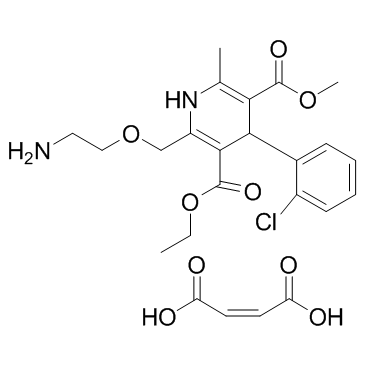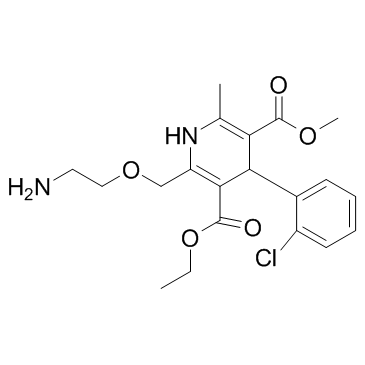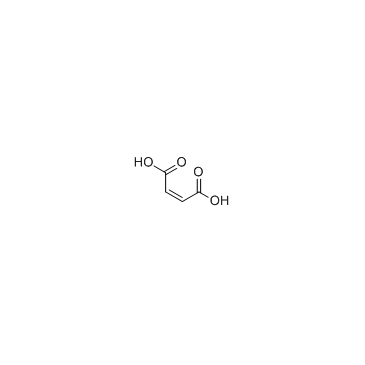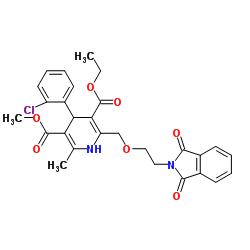Amlodipine maleate

Amlodipine maleate structure
|
Common Name | Amlodipine maleate | ||
|---|---|---|---|---|
| CAS Number | 88150-47-4 | Molecular Weight | 524.948 | |
| Density | N/A | Boiling Point | 527.2ºC at 760 mmHg | |
| Molecular Formula | C24H29ClN2O9 | Melting Point | N/A | |
| MSDS | N/A | Flash Point | 272.6ºC | |
Use of Amlodipine maleateAmlodipine maleate is a long-acting calcium channel blocker.Target: Calcium ChannelAmlodipine is a dihydropyridine calcium antagonist (calcium ion antagonist or slow-channel blocker) that inhibits the movement of calcium ions into vascular smooth muscle cells and cardiac muscle cells. Experimental data suggest amlodipine binds to both dihydropyridine and nondihydropyridine binding sites. The contractile processes of cardiac muscle and vascular smooth muscle are dependent upon the movement of extracellular calcium ions into these cells through specific ion channels. Amlodipine inhibits calcium ion influx across cell membranes selectively, with a greater effect on vascular smooth muscle cells than on cardiac muscle cells. Negative inotropic effects, or decreased heart muscle contractility, can be detected in vitro, but such effects have not been seen in intact animals at therapeutic doses. Serum calcium concentration is not affected by amlodipine. Within the physiologic pH range, amlodipine is an ionized compound (pKa = 8.6), and its interaction with the calcium channel receptor is characterized by a gradual rate of association and dissociation with the receptor binding site, resulting in a gradual onset of effect. Amlodipine is a peripheral arterial vasodilator that acts directly on vascular smooth muscle to cause a reduction in peripheral vascular resistance and reduction in blood pressure. From Wikipedia. |
| Name | Amlodipine maleate |
|---|---|
| Synonym | More Synonyms |
| Description | Amlodipine maleate is a long-acting calcium channel blocker.Target: Calcium ChannelAmlodipine is a dihydropyridine calcium antagonist (calcium ion antagonist or slow-channel blocker) that inhibits the movement of calcium ions into vascular smooth muscle cells and cardiac muscle cells. Experimental data suggest amlodipine binds to both dihydropyridine and nondihydropyridine binding sites. The contractile processes of cardiac muscle and vascular smooth muscle are dependent upon the movement of extracellular calcium ions into these cells through specific ion channels. Amlodipine inhibits calcium ion influx across cell membranes selectively, with a greater effect on vascular smooth muscle cells than on cardiac muscle cells. Negative inotropic effects, or decreased heart muscle contractility, can be detected in vitro, but such effects have not been seen in intact animals at therapeutic doses. Serum calcium concentration is not affected by amlodipine. Within the physiologic pH range, amlodipine is an ionized compound (pKa = 8.6), and its interaction with the calcium channel receptor is characterized by a gradual rate of association and dissociation with the receptor binding site, resulting in a gradual onset of effect. Amlodipine is a peripheral arterial vasodilator that acts directly on vascular smooth muscle to cause a reduction in peripheral vascular resistance and reduction in blood pressure. From Wikipedia. |
|---|---|
| Related Catalog | |
| References |
| Boiling Point | 527.2ºC at 760 mmHg |
|---|---|
| Molecular Formula | C24H29ClN2O9 |
| Molecular Weight | 524.948 |
| Flash Point | 272.6ºC |
| Exact Mass | 524.156128 |
| PSA | 174.48000 |
| LogP | 3.00720 |
| Storage condition | 2-8℃ |
|
~89% 
Amlodipine maleate CAS#:88150-47-4 |
| Literature: EOS ECZACIBASI OZGUN KIMYASAL URUNLER SANAYI VE TICARET A.S. Patent: WO2004/58711 A1, 2004 ; Location in patent: Page 15 ; |
|
~% 
Amlodipine maleate CAS#:88150-47-4 |
| Literature: US4572908 A1, ; |
|
~% 
Amlodipine maleate CAS#:88150-47-4 |
| Literature: US4572909 A1, ; US 4572909 A |
| 3,5-Pyridinedicarboxylic acid, 2-[(2-aminoethoxy)methyl]-4-(2-chlorophenyl)-1,4-dihydro-6-methyl-, 3-ethyl 5-methyl ester, (2Z)-2-butenedioate (1:1) |
| Amlodipine (±)-form Maleate |
| Norvasc |
| 2-[(2-aminoethoxy)methyl]-4-(2-chlorophenyl)-3-ethoxycarbonyl-5-methoxycarbonyl-6-methyl-1,4-dihydropyridine maleate |
| 3-Ethyl 5-methyl 2-[(2-aminoethoxy)methyl]-4-(2-chlorophenyl)-6-methyl-1,4-dihydropyridine-3,5-dicarboxylate (2Z)-but-2-enedioate (1:1) |
| AMLODIPINE MALEATE MM STANDARD |
| 3-Ethyl 5-methyl 2-[(2-aminoethoxy)methyl]-4-(2-chlorophenyl)-6-methyl-1,4-dihydro-3,5-pyridinedicarboxylate (2Z)-2-butenedioate (1:1) |
| UNII:CQ27G2BZJM |
| 2-(2-aminoethoxymethyl)-4-(2-chlorophenyl)-6-methyl-1,4-dihydropyridine-3,5-dicarboxylic acid 3-ethyl ester 5-methyl ester |
| AmlodipineMaleateC20H25C1N205.C4H404 |
| (±)-2-((2-Aminoethoxy)methyl)-4-(2-chlorophenyl)-1,4-dihydro-6-methyl-3,5-pyridinedicarboxylic Acid 3-Ethyl 5-Methyl Ester (Z)-2-Butenedioate (1:1) |
| 2-[(2-aminoethoxy)methyl]-4-(2-chlorophenyl)-1,4-dihydro-6-methyl-3,5-pyridinedicarboxylic acid 3-ethyl 5-methyl ester (z)-2-butenedioate |
| 3-ethyl-5-methyl-(4-RS)-2-[(2-aminoethoxy)methyl]-4-(2-chlorophenyl)-6-methyl-1,4-dihydropyridine-3,5-dicarboxylate maleate |
| (3-ethyl 5-methyl 2-[(2-aminoethoxy)methyl]-4-(2-chlorophenyl)-6-methyl-1,4-dihydropyridine-3,5-dicarboxylate) maleate |
| 3-Ethyl 5-Methyl (±)-2-((2-Aminoethoxy)methyl)-4-(o-chlorophenyl)-1,4-dihydro-6-methyl-3,5-pyridinedicarboxylate Maleate (1:1) |
| MFCD02259457 |
| Amlodipine maleate |





